
Blow Molding Plastic Packaging Procurement Intelligence Report, 2024 - 2030 (Revenue Forecast, Supplier Ranking & Matrix, Emerging Technologies, Pricing Models, Cost Structure, Engagement & Operating Model, Competitive Landscape)
- Published Date: Aug, 2023
- Base Year for Estimate: 2023
- Report ID: GVR-P-10518
- Format: Electronic (PDF)
- Historical Data: 2021 - 2022
- Number of Pages: 60
Blow Molding Plastic Packaging - Procurement Trends
“The blow molding plastic packaging market growth is driven by the increase in adoption of the automation and innovative technology in food, beverage, pharmaceutical, and personal care.”
Procurement of blow molding plastic packaging has gained an uptick on the back of heightened demand from construction, automobiles, and food & beverages industries. The global market is poised to grow at a CAGR of 5.3% from 2024 to 2030. Dynamics such as high-impact strength and custom manufacturing make blow molding a pivotal process in plastic packaging. For instance, beverage industries are heavily investing in this portfolio, which accounts for 40% - 50% of the market share. Technological innovation and R&D to develop sustainable materials is another factor driving the growth.
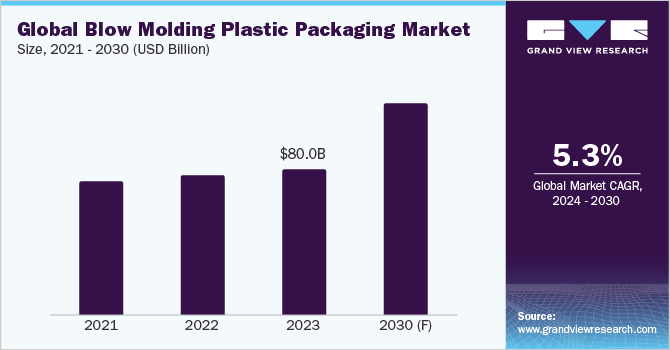
The global blow molding plastic packaging market size was estimated at USD 80.04 billion in 2023. An emphasis on sustainable and eco-friendly products has led to the development of reduced-weight plastic containers, which weigh 8 to 12 grams less and contain 25% less plastic than before. This helps in cutting logistics costs, raw material costs, and carbon footprint.
After the outbreak of the COVID-19 pandemic, health and safety concerns drastically increased the usage of packed foods and beverages. This has increased the manufacturing of various types of sizes and of food packaging materials to cater to the changing needs of the food & beverage industry. Food and beverages constitute 50% of the whole plastic packaging market.
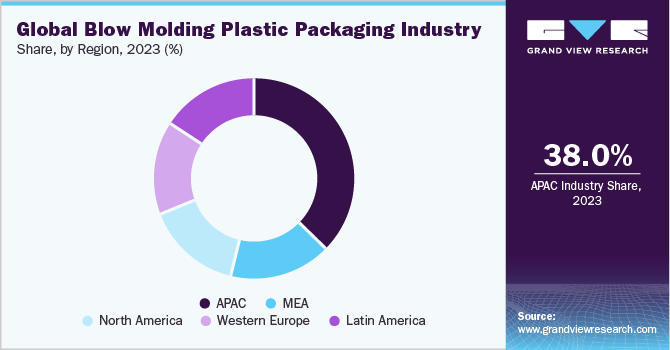
Liquiform is an innovative technology that is rapidly emerging in the ecosystem. Through its cutting-edge technology, it uses consumable and pressurized liquid, alternating with compressed air to develop plastic containers. This process involves combining bottle forming and the filling process in one step which eliminates numerous steps involved in manufacturing, resulting in reduced cost and the wastage involved. The technology has been validated with a wide range of packaging substrates, and varied conditions for ambient, cold, and hot filled PET containers.
Leading companies are using Artificial Intelligence (AI), IoT, and big data as they help automate repetitive tasks and also enable them to collect and analyze data that can be shared in real time to improve efficiency and productivity by reducing errors. For instance, in 2022, Bekum Maschinenfabrik GmbH announced that it was using AI to automate the loading and unloading of molds.
In addition, the rising concerns toward cost-efficient and sustainable eco-friendly products are expected to foster blow molding plastic packaging market expansion.
Supplier Intelligence
“How is the nature of the blow molding plastic packaging industry? What are the initiatives taken by the suppliers in this market?”
The industry is fragmented, with the presence of several players in the market. Key players are collaborating with various organizations to develop materials or technologies such as 3D printing, and the use of biomaterials to provide innovative and sustainable packaging materials. For instance, in October 2021, Coca-Cola, UPM, and Changchun Meihe teamed up to develop and commercialize the next-gen biomaterials to efficiently convert second-gen biomass to plant-based monoethylene glycol. This has helped them reduce bio-waste, which is then converted to monoethylene glycol, a raw material for manufacturing packaging materials. For an eco-friendly sustainability drive, Coca-Cola and UPM, through their partnership, have developed a renewable solution to drive a shift from crude oil-based materials. UPM is one of the leading companies in the bio-based forest industry; it contemplates creating solutions and technologies to develop sustainable raw materials.
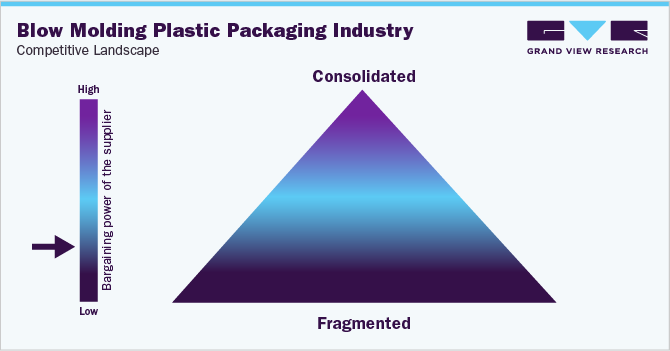
The competition is intense between players as many large and small players offer a range of services. Suppliers provide raw materials, designing and manufacturing, and collaborative technological solutions. Due to the increasingly growing large number of companies that require these materials/services, suppliers have a high bargaining power, which has reduced the marginal gap in the market and reshaped the procurement landscape. Large players must accumulate local players or sources from LCC countries to sustain profitability in the market.
Key suppliers covered in the industry:
-
Niagara Bottling, LLC
-
Petainer UK Holdings Ltd.
-
Nampak Plastics Europe Limited
-
Plastipak Packaging Inc.
-
Plastic Technologies Inc.
-
Toyo Seikan Kaisha Ltd.
-
Graham Packaging Company Inc.
-
Logoplaste Group
-
Greiner Packaging International
-
Sailor Plastics
-
Artenius Pet Packaging Europe (Appe)
-
Amcor Rigid Plastics
-
Constar Plastics B.V.
-
Esterform Ltd.
-
Berry Global Inc.
Pricing and Cost Intelligence
“What are some of the major cost components involved in blow molding plastic packaging? Which factors impact the cost of blow molding plastic packaging?”
Raw material, design & engineering, and manufacturing form the major cost components when it comes to producing blow molding plastic packaging. There are a number of factors that can affect the cost, including the type of plastic used, the size and complexity of the product being developed, and the volume of production. Businesses should carefully consider all these factors when producing packaging materials to ensure that they are competitive and profitable.
The following chart provides insights into various costs incurred during the production of blow molding plastic packaging. The major cost heads are shown below.
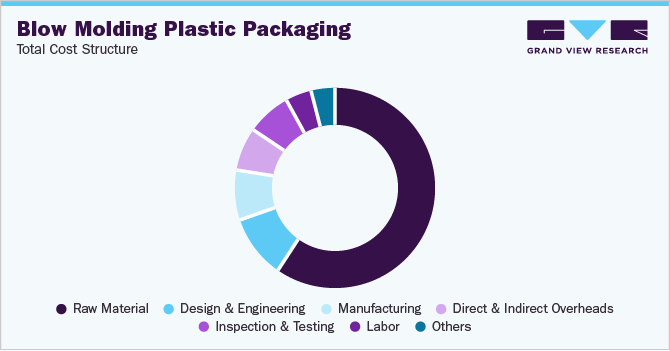
The cost of producing blow molding plastic packaging can be influenced by various factors. First, the type of plastic used, such as Polyethylene (PE), Polypropylene (PP), Polyethylene Terephthalate (PET), and Polyvinyl Chloride (PVC), significantly affect the cost part. It constitutes about 50% - 60% of the total cost involved during production. Additionally, the type of production method creates an impact on product output varying from the size, nature, and complexity of the product.
A more complex product requires more powerful production methods, such as the injection molding technique, which costs 50%–60% more than the traditional molding technique, which in turn leads to higher upfront expenses. Furthermore, along with the complexity, the tonnage pressure, which helps keep the mold intact, constitutes around USD 3000 to 6000 for a single cavity and up to USD 90,000, depending upon the capacity of production.
Other costs include tooling, shipping, and overheads. Shipping costs will depend on the distance that the parts have to be shipped. Overhead costs include rent, utilities, and insurance. The total cost will vary depending on the specific factors involved, but a general estimate is that the cost of blow molding a plastic part will be between USD 0.50 and USD 5.00 per part.
The procurement price depends on the type of blow molding used for packaging, such as extrusion, injection, and injection stretch blow mold. Packaging done through extrusion type has comparatively lower pricing than packaging done through injection molding. Equipped technology, such as 3D printing, miniaturization, lightweight, and automation-used during product packaging-has a higher impact on the pricing.

Raw materials constitute the majority cost part for the production, with around 50-60% of the total production. With the wide availability of raw materials, suppliers have high bargaining power, which, in return, decreases the profitability margin of the small players. The rise in the requirement for packaging substrate in various industries, mainly due to health and safety concerns (post-COVID-19), caused a higher impact and rise in the Producer Price Index (PPI) to grow to 175 in 2022 from 141 in 2014.
Sourcing Intelligence
“Which countries are the leading sourcing destinations for blow molding plastic packaging production?”
Asia Pacific is the major procurement region in the production of blow molding plastic packaging due to the availability of various raw materials, the latest technology, and cheap labor. China is considered to have the largest production of HDPE, a major raw material in the market. In 2023, China's production capacity of HDPE reached 4.16 million metric tons, the highest among all other countries after the U.S. In terms of blow molding packaging sourcing intelligence, the top six countries are China, Japan, the U.S., India, Brazil, and Germany.
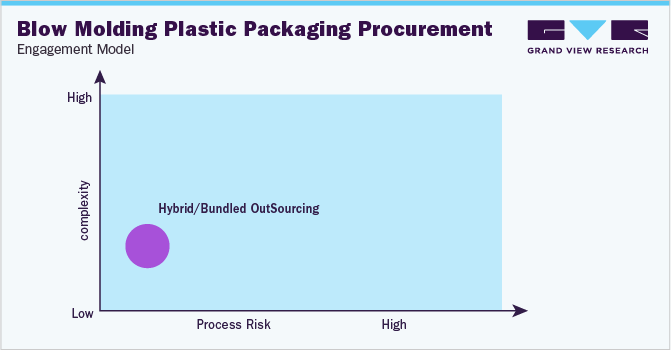
In terms of engagement, suppliers of blow-molded plastic packaging adopt a hybrid model. Many industries are rushing to adopt the power that comes with cutting-edge technologies. Injection molding cost is one of the significant cost drivers determining the price of the product. China has lower labor and production expenses than other countries, so the majority of countries outsource their production to China due to its well-developed manufacturing infrastructure. Manufacturing in China also provides players access to a global and expanded market.
In the hybrid outsourcing model, the suppliers outsource some parts of the overall operation to third parties. Generally, critical operations are carried out in-house by the client. Due to the certifications and complexity involved during production, many suppliers outsource critical operations to third-party vendors to have better productivity.
The report also provides details regarding peer analysis, recent supplier developments, supply-demand analysis, competitive landscape, KPIs, SLAs, risk assessment, negotiation strategies and low-cost/best-cost sourcing analysis. In the report, we have tried to provide a holistic industry perspective, an overview of the supplier landscape – the presence of different types of players and the competitive pressure within the industry as a whole (PORTER’s). Similarly, the supply chain practices under sourcing are also covered. One such instance is the operating or engagement model which encompasses all the business processes conducted within an organization. It is an integral aspect of the company's operations and plays a crucial role in its success.
Blow Molding Plastic Packaging Procurement Intelligence Report Scope
|
Report Attribute |
Details |
|
Growth Rate |
CAGR of 5.3% from 2024 to 2030 |
|
Base Year for Estimation |
2023 |
|
Pricing Growth Outlook |
10% - 15% (Annually) |
|
Pricing Models |
Cost plus pricing model, volume-based pricing model |
|
Supplier Selection Scope |
Cost and pricing, past engagements, productivity, geographical presence |
|
Supplier Selection Criteria |
By type, operating capability, quality measures, technology, certifications, regulatory compliance, and others |
|
Report Coverage |
Revenue forecast, supplier ranking, supplier positioning matrix, emerging technology, pricing models, cost structure, competitive landscape, growth factors, trends, engagement, and operating model |
|
Key Companies Profiled |
Niagara Bottling LLC, Petainer UK Holdings Ltd., Nampak Plastics Europe Limited, Plastipak Packaging Inc., Esterform Ltd., Plastic Technologies Inc., Toyo Seikan Kaisha Ltd., Graham Packaging Company Inc., Logoplaste Group, Greiner Packaging International, Sailor Plastics, Artenius Pet Packaging Europe (Appe), Amcor Rigid Plastics, Constar Plastics B.V., Berry Global Inc. |
|
Regional Scope |
Global |
|
Historical Data |
2021 - 2022 |
|
Revenue Forecast in 2030 |
USD 162.11 billion |
|
Quantitative Units |
Revenue in USD billion and CAGR from 2024 to 2030 |
|
Customization Scope |
Up to 48 hours of customization free with every report. |
|
Pricing and Purchase Options |
Avail customized purchase options to meet your exact research needs. Explore purchase options |
Frequently Asked Questions About This Report
b. The global blow molding plastic packaging market size was valued at approximately USD 80.04 billion in 2023 and is estimated to witness a CAGR of 5.3% from 2024 to 2030.
b. The increasing technological advancement and rising demand by various industries are driving the growth of the category. Advancement in track and trace technology has also a major role in the growth of the industry
b. According to the LCC/BCC sourcing analysis, China, Japan, the U.S., and India are the ideal destinations for sourcing the category items
b. This market is fragmented with the presence of many large players competing for market share. Some of the key players are Niagara Bottling Llc, Petainer UK Holdings Ltd., Nampak Plastics Europe Limited, Plastipak Packaging Inc., and Esterform Packaging.
b. Raw material, design & engineering, and manufacturing are the major key cost components of this category. Other key costs include inspection and testing, and direct and indirect overhead costs.
b. Acquiring or partnering with regional players to expand their distribution lines, sourcing from low-cost countries, and choosing suppliers that follow comprehensive standards and assurance policies, and quality certifications to support responsible sourcing of the industry.
Add-on Services
Should Cost Analysis
Component wise cost break down for better negotiation for the client, highlights the key cost drivers in the market with future price fluctuation for different materials (e.g.: steel, aluminum, etc.) used in the production process
Rate Benchmarking
Offering cost transparency for different products / services procured by the client. A typical report involves 2-3 case scenarios helping clients to select the best suited engagement with the supplier
Salary Benchmarking
Determining and forecasting salaries for specific skill set labor to make decision on outsourcing vs in-house.
Supplier Newsletter
A typical newsletter study by capturing latest information for specific suppliers related to: M&As, technological innovations, expansion, litigations, bankruptcy etc.




